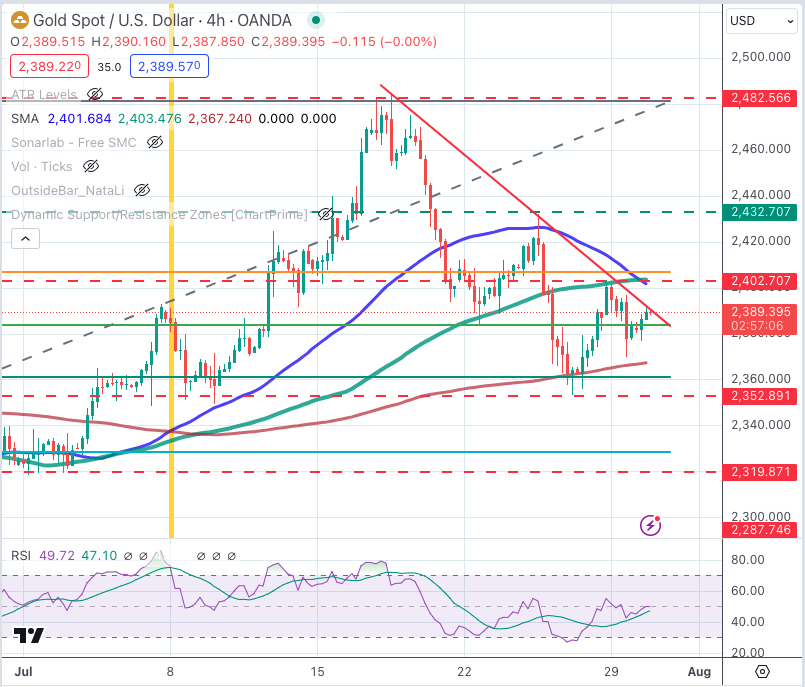Gold picks up against a weaker Dollar ahead of central banks’ decisions
- Gold advances with risk appetite returning as geopolitical fears ease.
- Hopes that the Fed might hint towards monetary easing on Wednesday keep US Treasury yields near mid-term lows.
- XAU/USD needs to break the $2,400 resistance to cancel the broader bearish structure.
Gold price (XAU/USD) found buyers after a moderate pullback on Monday. The precious metal has been going through a mild recovery during Tuesday’s Asian session that has continued in the European morning.
News reporting that Israel is willing to avoid an all-out war in the Middle East has eased geopolitical concerns, allowing the safe-haven US Dollar (USD) to trim some gains.
Investors’ focus is now on the Federal Reserve’s (Fed) monetary policy decision, due on Wednesday. The bank will highly likely leave interest rates unchanged, but the attention will be on the ensuing press release by Fed Chair Jerome Powell. With price pressures on a disinflationary trend and the labour market finally showing signs of exhaustion, Powell suggesting that the easing cycle might start before December. That would harm the US Dollar and support precious metals.
Daily digest market movers: Gold picks up within recent range with all eyes on the Fed
- Gold is regaining some of the ground lost on Monday, favoured by a somewhat brighter market mood as concerns of a full-blown war in the Middle East have eased.
- Israeli authorities assured that they want to retaliate Hizbullah, for the rocket attack that killed 12 people on the weekend, but that they want to avoid a regional war in the Middle East. This has calmed market fears.
- Later today, the Conference Board is expected to show that the Consumer Sentiment Index deteriorated marginally in July, to a reading of 99.5 from the 100.4 posted in the previous month.
- In the same line, US JOLTS Job Openings are seen to have declined to 8.03 million in June from the 8.14 million openings reported in May.
- The Fed is releasing its monetary policy decision on Wednesday, and the recent inflation readings have boosted market expectations that the bank might signal the exit of the restrictive cycle.
- US 10-year yields are marginally above four-month highs, while the 2-year yield, the most closely related to interest rate expectations, remains depressed at their lowest levels since February.
- The CME Group’s Fed Watch tool is pricing a 95% chance that the Fed will keep rates on hold on Wednesday and a 100% chance that rate cuts will start in September.
Technical analysis: XAU/USD remains capped below the $2,400 resistance level
XAU/USD is on a corrective decline after having been capped nearly $2,500 in mid-July. The pair has found significant support at the 61.8% Fibonacci retracement of the June-July bullish run, near $2,360, and the higher low printed last week suggests that the correction might have been completed.
The 4-hour Relative Strength Index (RSI) indicator is pulling higher and about to cross the key 50 level. The precious metal, however, might need an extra boost to breach the 2,400 resistance area. Soft data today and a dovish Fed would probably do it. The next target, in this case, would be $2,430.
On the downside, supports are at the mentioned 61.8% Fibonacci retracement, at $2,350, ahead of $2,320.
XAU/USD 4-hour chart

Gold FAQs
Gold has played a key role in human’s history as it has been widely used as a store of value and medium of exchange. Currently, apart from its shine and usage for jewelry, the precious metal is widely seen as a safe-haven asset, meaning that it is considered a good investment during turbulent times. Gold is also widely seen as a hedge against inflation and against depreciating currencies as it doesn’t rely on any specific issuer or government.
Central banks are the biggest Gold holders. In their aim to support their currencies in turbulent times, central banks tend to diversify their reserves and buy Gold to improve the perceived strength of the economy and the currency. High Gold reserves can be a source of trust for a country’s solvency. Central banks added 1,136 tonnes of Gold worth around $70 billion to their reserves in 2022, according to data from the World Gold Council. This is the highest yearly purchase since records began. Central banks from emerging economies such as China, India and Turkey are quickly increasing their Gold reserves.
Gold has an inverse correlation with the US Dollar and US Treasuries, which are both major reserve and safe-haven assets. When the Dollar depreciates, Gold tends to rise, enabling investors and central banks to diversify their assets in turbulent times. Gold is also inversely correlated with risk assets. A rally in the stock market tends to weaken Gold price, while sell-offs in riskier markets tend to favor the precious metal.
The price can move due to a wide range of factors. Geopolitical instability or fears of a deep recession can quickly make Gold price escalate due to its safe-haven status. As a yield-less asset, Gold tends to rise with lower interest rates, while higher cost of money usually weighs down on the yellow metal. Still, most moves depend on how the US Dollar (USD) behaves as the asset is priced in dollars (XAU/USD). A strong Dollar tends to keep the price of Gold controlled, whereas a weaker Dollar is likely to push Gold prices up.

